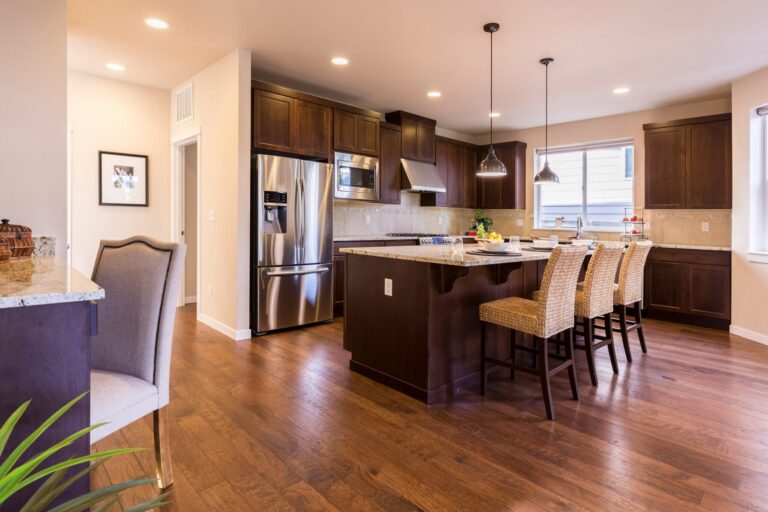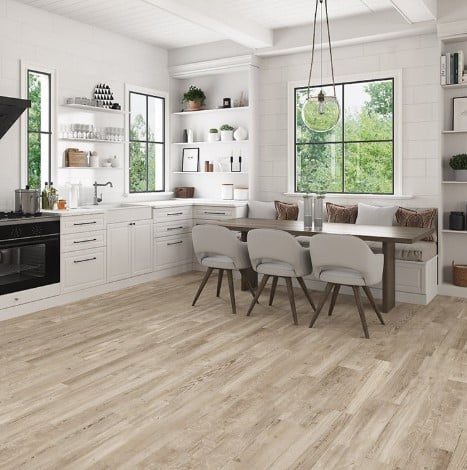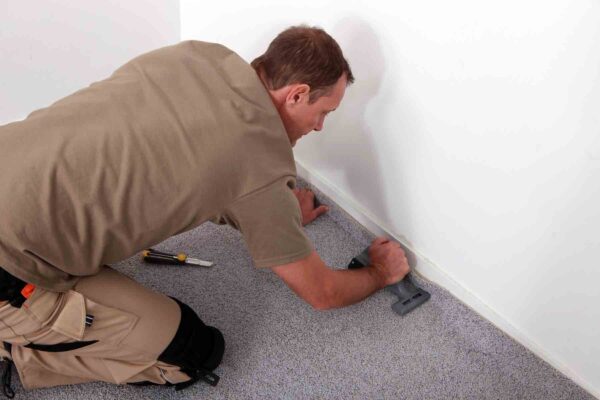
Top Factors to Consider Before Choosing Kitchen Flooring
Water Resistance and Spills
Kitchens get wet often. Pick floors that don’t warp, stain, or get slippery when wet. Options like luxury vinyl and tile are great for kitchens.
Durability for Heavy Foot Traffic
Kitchens have a lot of movement. Floors should handle busy days and dropped things. Choose materials that don’t dent or scratch easily.
Comfort Underfoot
If you stand a lot while cooking, comfort matters. Floors like vinyl can be softer than tile. You can also use mats for extra comfort.
Ease of Cleaning and Maintenance
Kitchens get messy. Choose floors that are easy to clean, like tile or vinyl. These make cleaning spills simple.
Visual Style and Design Cohesion
Kitchen floors affect the room’s look. Think about how the floor’s color and texture match with cabinets and counters. Whether you like wood, stone, or patterns, make sure it all fits together.
Kitchen Flooring Factors Comparison Chart
| Material | Water Resistance | Durability | Comfort | Maintenance | Style Compatibility |
|---|---|---|---|---|---|
| Luxury Vinyl Plank (LVP) | ✅ Waterproof | ✅ High | ✅ Soft | ✅ Easy | ✅ Versatile |
| Porcelain Tile | ✅ Waterproof | ✅ High | ❌ Hard | ✅ Easy | ✅ Modern/Classic |
| Ceramic Tile | ✅ Water-Resistant | ✅ High | ❌ Hard | ✅ Easy | ✅ Traditional |
| Laminate | ⚠️ Water-Resistant | ✅ Moderate | ⚠️ Moderate | ✅ Easy | ✅ Modern |
| Sheet Vinyl | ✅ Waterproof | ✅ Moderate | ✅ Soft | ✅ Easy | ✅ Varied |
| Cork | ⚠️ Water-Resistant | ⚠️ Moderate | ✅ Cushioned | ⚠️ Moderate | ✅ Eco-Friendly |
| Concrete | ✅ Waterproof | ✅ High | ❌ Hard | ✅ Easy | ✅ Industrial |
| Natural Stone | ⚠️ Water-Resistant | ✅ High | ❌ Hard | ❌ High | ✅ Luxurious |

Best Kitchen Flooring Materials (Pros & Cons)
Selecting the right kitchen flooring involves considering style, performance, and practicality. Here are popular kitchen flooring options in 2025, with their benefits and drawbacks:
Luxury Vinyl Plank (LVP) in the Kitchen
Pros: LVP is a leading choice for kitchen floors, offering waterproof features, affordability, and realistic wood and stone looks with added comfort.
Cons: Lower-quality LVP might dent or fade with heavy use or sunlight.
Tile Flooring in the Kitchen (Ceramic & Porcelain)
Pros: Tile is a durable and water-resistant option, available in various finishes and colors.
Cons: Tile can be cold and hard, often needing rugs or underfloor heating for comfort.
Laminate Flooring in the Kitchen
Pros: Laminate is a budget-friendly choice, offering modern styles and water-resistant options that are easy to maintain.
Cons: Traditional laminate can be affected by standing water and may not last as long as tile or vinyl.
| # | Material | Pros (Kitchen Use) | Cons (Kitchen Use) |
|---|---|---|---|
| 1 | Luxury Vinyl Plank (LVP) | Waterproof, realistic visuals, affordable, soft underfoot | Lower-end versions may dent or fade in busy kitchens |
| 2 | Porcelain/Ceramic Tile | Water-resistant, very durable, great for high-moisture areas | Cold and hard underfoot, may need rugs or heating |
| 3 | Sheet Vinyl | Seamless waterproof surface, soft, quiet, budget-friendly | Less realistic texture; not as durable over time in busy areas |
| 4 | Engineered Wood | More moisture-tolerant, brings natural warmth | Still vulnerable to prolonged water exposure |
| 5 | Laminate Flooring | Affordable with water-resistant designs | May swell if water seeps into seams |
| 6 | Concrete | Durable and waterproof when sealed, ideal for industrial styles | Cold and hard; may need sealing and heating |
| 7 | Cork | Cushioned, quiet, eco-friendly choice | Needs sealing and UV protection |
| 8 | Natural Stone | Elegant and durable | Expensive, requires sealing, can be slippery |
| 9 | Hardwood Flooring | Timeless, warm look | Not suitable for heavy moisture without maintenance |

Waterproof vs. Water-Resistant: What You Really Need For Your Kitchen Floors
When picking kitchen flooring, it’s important to know how the material deals with water. Not all floors that handle water do so the same way — people often mix up “waterproof” and “water-resistant”.
🔍 Key Differences Explained
- Waterproof kitchen flooring is completely protected from water — it can be soaked or steam-cleaned without getting damaged.
- Water-resistant kitchen flooring handles small spills but might absorb water if it sits too long or leaks into edges.
Think of waterproof as a raincoat, and water-resistant as a hoodie — both protect, but one is better in heavy rain.
💧 Which Flooring Materials Are Truly Waterproof?
For kitchens with spills or heavy cleaning, these waterproof kitchen flooring materials are best:
- Luxury Vinyl Plank (LVP) and Sheet Vinyl – Completely waterproof, great for families and busy kitchens.
- Porcelain and Ceramic Tile – Waterproof with proper grout and sealing.
- Concrete Flooring – Waterproof once sealed; ideal for modern kitchens.
🏡 Best Flooring for High-Moisture Kitchens
For homes with kids, pets, or lots of cooking, these floors offer waterproofing, comfort, and durability:
- Luxury Vinyl Plank (LVP) – Best for waterproof performance and style.
- Sheet Vinyl – Offers seamless protection at a lower cost.
- Tile (Porcelain or Ceramic) – Very durable and waterproof when installed correctly.
- Engineered Wood with Water-Resistant Core – Real wood look with moderate water protection.
Avoid using solid hardwood or unsealed cork in moist kitchens without regular upkeep.
Easy-to-Clean Kitchen Flooring Options
A clean kitchen isn’t just about hygiene — it’s about picking kitchen flooring that hides messes and makes life easier. With crumbs, spills, or daily foot traffic, some materials are better for easy upkeep.
🧼 Best Kitchen Flooring Materials for Stain Resistance
- Porcelain and Ceramic Tile – Naturally stain-resistant and simple to clean, even after greasy splatters or sauce spills.
- Luxury Vinyl Plank (LVP) – The top layer resists stains, scuffs, and grime — perfect for busy kitchen areas.
- Sheet Vinyl – Its smooth surface stops spills from soaking in and makes cleaning fast.
- Sealed Concrete – Very stain-resistant when sealed; great for modern kitchens with bold looks.
👀 Finishes That Hide Dirt and Crumbs
Not all kitchen flooring shows mess the same way. These finishes are great for hiding daily debris:
- Matte Finishes – Reduce glare and hide smudges and dust better than shiny surfaces.
- Textured Surfaces – Subtle wood grains or stone textures help hide crumbs and footprints.
- Mid-Tone Neutrals – Shades like beige, taupe, or greige are perfect for hiding dirt and pet hair.
✨ Maintaining Shine and Durability
To keep your kitchen floor looking great:
- Sweep or vacuum regularly to remove grit that can scratch the surface.
- Use a damp mop with approved cleaners — avoid harsh chemicals on vinyl, laminate, or sealed wood.
- Reapply sealant for materials like concrete, cork, or natural stone every few years to guard against stains and moisture.
- Add felt pads to the bottom of kitchen chairs and stools to reduce wear over time.

Cost Breakdown Of Kitchen Flooring By Material & Labor
Choosing the right kitchen flooring affects your renovation budget greatly. With the right info, you can manage cost, performance, and durability. Here’s a simple guide on pricing, installation options, and value over time.
💰 Material Cost Per Square Foot (2025 Averages)
| Material | Price (Per Sq Ft) |
|---|---|
| Sheet Vinyl | $1 – $3 |
| Laminate Flooring | $1.50 – $4 |
| Luxury Vinyl Plank | $2 – $5 |
| Ceramic Tile | $2 – $6 |
| Porcelain Tile | $3 – $10 |
These prices are for mid-range quality products. Extras like premium designs and special finishes can increase the cost. Want more details?
🛠️ Installation Cost: DIY vs. Professional
| Material | DIY-Friendly? | Professional Install Cost (Per Sq Ft) |
|---|---|---|
| Sheet Vinyl | ✅ Very Easy | $1 – $3 |
| Laminate | ✅ Easy | $2 – $5 |
| Luxury Vinyl Plank | ✅ Easy | $2 – $6 |
| Ceramic/Porcelain Tile | ❌ Moderate-Hard | $5 – $15 |
DIY can save on labor, but complex materials like tile are best for flooring installation professionals unless you’re experienced. Want to try DIY? Check out our guides:
- How To Install Laminate Flooring (DIY Guide)
- How To Install Vinyl Flooring (DIY Guide)
- How To Install Tile Flooring (DIY Guide)
📈 Longevity & Value Over Time
- Best Value Long-Term: Porcelain Tile and Luxury Vinyl Plank — great for durability and style.
- Budget-Friendly with Good Lifespan: Laminate and Sheet Vinyl — easy to install and maintain, but shorter lifespan (~10–15 years).

Eco-Friendly Kitchen Flooring Options
If you want a healthier home or to be more eco-friendly, picking the right eco-friendly kitchen flooring is important. The good news is that sustainable materials are now stylish, strong, and help indoor air quality.
🌱 Best Eco-Friendly Kitchen Flooring Options
- Cork Flooring – Cork comes from the renewable bark of cork oak trees. It’s taken without hurting the tree. This flooring is naturally antimicrobial, soft to walk on, and good for energy-saving kitchens because it insulates well.
- Bamboo Flooring – Bamboo is a fast-growing grass, not wood, and is very renewable. It gives a modern look to kitchens. Strand-woven bamboo is very strong, perfect for busy homes.
- Reclaimed Hardwood – This flooring reuses old materials, cutting down on the need for new trees. Each piece has a unique story and rustic charm, great for farmhouse or vintage-style kitchens.
🏡 VOC Ratings and Health Considerations
Not all “natural” floors are safe for indoor air. Look for low-VOC or zero-VOC certified flooring to prevent harmful chemicals from being released:
- Look for certifications like FloorScore, Greenguard GOLD, or CARB Phase 2 compliance.
- Pick water-based finishes and adhesives.
- Be cautious with vinyl or laminate products that have formaldehyde or phthalates, unless they are labeled low-emission.
Eco-friendly kitchen floors are not just about the materials; they also help keep your family’s health and indoor air quality safe.
15 Kitchen Flooring Ideas for 2025
- Herringbone Pattern in Luxury Vinyl Plank
Herringbone patterns in luxury vinyl planks offer a classic design with modern durability. This style adds visual interest and sophistication to kitchens while being resistant to moisture and wear. Discover our Luxury Vinyl Plank selections

- Matte Finish Porcelain Tiles
Matte finish porcelain tiles provide a sleek, contemporary look that minimizes glare and hides smudges, making them ideal for busy kitchens. Browse our Porcelain Tile collection
- Seamless Indoor-Outdoor Transitions
Using consistent flooring materials, like porcelain tiles, from the kitchen to adjacent outdoor areas creates a harmonious flow, perfect for entertaining and open-plan living. View our Laminate Flooring options

- Natural Stone-Look Porcelain Tiles
Porcelain tiles that mimic natural stone offer the luxurious appearance of materials like marble or slate with enhanced durability and lower maintenance. Explore our Porcelain Tile selections

- Large Format Tiles
Large format tiles reduce grout lines, resulting in a seamless and expansive look that enhances the kitchen’s spaciousness. Check out our Ceramic Tile collection

- Wood-Look Porcelain Tiles
Combining the warmth of wood aesthetics with the durability of porcelain, these tiles are resistant to moisture and wear, making them suitable for high-traffic kitchen areas. Discover our Porcelain Tile options

- Patterned & Decorative Tiles
Incorporating bold patterns, such as geometric or Moroccan designs, adds personality and a focal point to the kitchen floor. Browse our Porcelain Tile collection

- Neutral & Earthy Tones
Colors like beige, taupe, and soft greys are trending, providing a versatile backdrop that complements various kitchen styles and color schemes. View our Porcelain Tile collection
- Checkerboard Patterns
Classic black-and-white checkerboard floors make a comeback, providing a timeless and playful design element. Browse our Porcelain Tile collection

- Terra-Cotta Tiles
Embracing the warmth of terra-cotta tiles brings a rustic charm and earthy tone to the kitchen environment. Discover our Porcelain Tile options

Final Tips Before You Buy Kitchen Flooring
Before deciding, take time to check a few key steps. These small actions help you save time and money and avoid future problems when picking the right kitchen flooring.
📦 1. Order Extra Material for Cuts and Waste
Buy 10–15% more flooring than your kitchen’s size needs. This covers waste from cuts, mistakes, and future repairs. Running out of material can delay your project.
💡 2. Test Flooring Samples in Your Kitchen Lighting
Flooring can look different in various lights. What seems warm in the store might look different at home. Place samples on your floor and check them at different times to see how they fit with your kitchen’s light.
🛡️ 3. Understand Manufacturer Warranties
Read warranties carefully to know:
- If they cover water damage, wear, fading, or installation issues.
- If professional installation is needed for warranty.
- What voids the warranty, like using the wrong cleaners or DIY installs on some products.
🎯 Bonus Tip: Match Floor Choice to Lifestyle
- Busy family home? Choose waterproof and easy-care options like LVP or tile.
- Design-focused kitchen? Look at trendy styles like herringbone vinyl or stone-look tiles.
- Eco-conscious household? Pick cork, bamboo, or reclaimed wood with low-VOC labels.
Do You Need Help Choosing or Installing Your Kitchen Flooring?
After learning about the best kitchen flooring materials, costs, and design ideas, you’re closer to having a lovely and practical kitchen. If you prefer, our expert team can handle the measuring, prep, and installation for you.
We manage everything — from checking the subfloor and testing moisture to exact installation of luxury vinyl plank, porcelain tile, and laminate.
We help you choose the right kitchen flooring based on your lifestyle, layout, and budget — whether you need waterproof durability, easy-care comfort, or stylish design.
Click here to contact us today to schedule your free in-home consultation and see if we serve your area!






